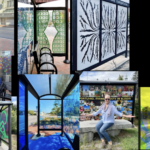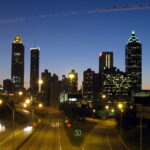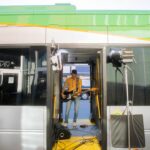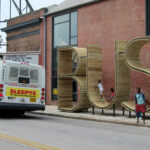Seattle was one of the first cities in the country to pass a public arts ordinance (in 1973) and to make one percent of the budget for any eligible capital project available for the commission, purchase and installation of artworks in a variety of settings. Now, artists not only develop public art plans, but also integrate art into the city’s routine work and infrastructure, while the regional transit agency partners on a suite of arts engagement programs.
The challenge
Seattle’s percent-for-art ordinance specifies that 1 percent of eligible city capital improvement project funds be set aside for the commission, purchase and installation of artworks in a variety of settings. By providing opportunities for individuals to encounter art in parks, libraries, community centers, on roadways, bridges and other public venues, they simultaneously enrich citizens’ daily lives and give voice to artists.
In 2013, the Seattle DOT hired an artist to develop an art plan which “is focused as a plan of action,” according to an online introduction, “comprehensively detailing how Seattle can become a national leader in creating a more humane, layered, beautiful and relevant transportation system.” The introduction continues:
“It offers a completely new methodology for rethinking the practicality and use of our shared right-of-way. By employing the work of artists, the creativity of citizens and the ingenuity of SDOT employees, the gradual implementation of this plan will contribute significantly to a Seattle whose streets and sidewalks celebrate life, discovery and creativity.”
The project
This plan commissioned by Seattle DOT, available in three parts, provides an overview and visual encyclopedia of art in the right-of-way as well as a toolkit for project managers with handy one-page examples of various project types. Vaughn Bell, while employed as an artist at the Seattle DOT, spoke of her common ground with her colleagues in an interview with Americans for the Arts.
“For me, it resides in a fascination with how people experience places. Adding a subtle finish to a concrete wall or an imprint to a sidewalk, on a project which would otherwise be concerned almost entirely with ‘moving goods and people’ through the city, I am hoping that we can create a moment for a higher degree of attention and connection to the place.”
– Vaughn Bell, artist contracted at Seattle DOT
The results
“Community members have come to expect arts engagement as part of the transit project development process,” according to Sound Transit Art Program Manager Barbara Luecke. Among the collaborations, Metro Transit in King County has involved youth and other members of the community in designing and painting murals at local stops since 1989. Metro contributes panels and paint, and members of the community donate their artistic talent.
More recently, Metro expanded the scope and depth of its programming in partnership with King County’s cultural services agency, 4Culture. Since 1992, Metro Transit and 4Culture have presented poetry from community members on placards placed above the bus seats. In 2015, the Poetry on Buses program expanded to include poetry workshops in five languages, an online poetry portal, and digital artworks designed for mobile devices meant to be accessed on (and call attention to) the region’s new Wi-Fi-enabled rapid bus service, RapidRide.
The City of Seattle continues to provide grants to individuals and nonprofit organizations through their Vibrant Communities program offering free public amenity permits that can be used to install a variety of elements that enhance the street for the public.
Key Partners: Seattle Office of Arts & Culture, Seattle Department of Transportation















